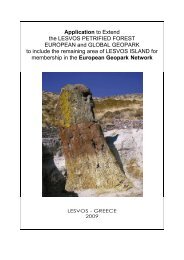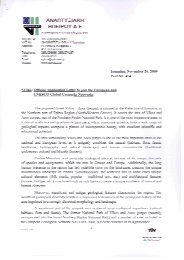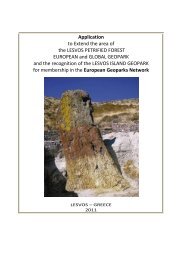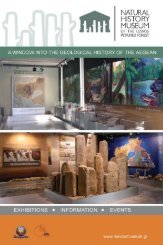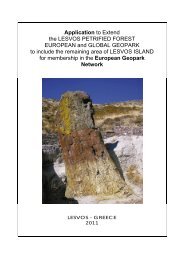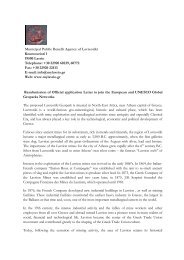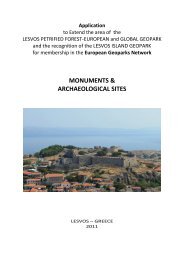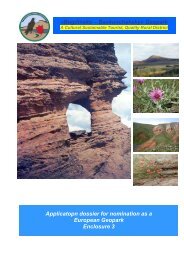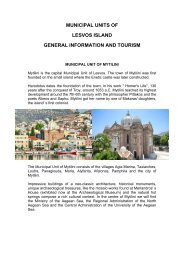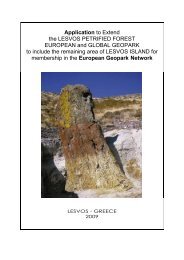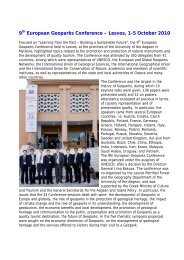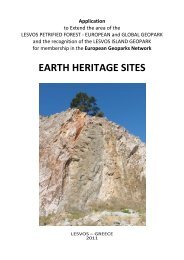Application to Extend the area of the LESVOS PETRIFIED FOREST ...
Application to Extend the area of the LESVOS PETRIFIED FOREST ...
Application to Extend the area of the LESVOS PETRIFIED FOREST ...
You also want an ePaper? Increase the reach of your titles
YUMPU automatically turns print PDFs into web optimized ePapers that Google loves.
According <strong>to</strong> <strong>the</strong> published data <strong>the</strong> geological structure <strong>of</strong> Lesvos Island comprises <strong>the</strong><br />
following rock‐units.<br />
• An au<strong>to</strong>chthonous unit <strong>of</strong> Permo‐Triassic age, including schists, quartzites,<br />
metasands<strong>to</strong>nes, phyllites with intercalation <strong>of</strong> marbles and crystalline carbonates.<br />
These rocks are widely extended on <strong>the</strong> Sou<strong>the</strong>ast part <strong>of</strong> <strong>the</strong> island, while in <strong>the</strong><br />
Northwest part <strong>the</strong>y have a ra<strong>the</strong>r small extension.<br />
• The allochthonous units that represent remnants <strong>of</strong> an ophiolitic sequence, comprising<br />
basic and ultrabasic rocks and associated deep‐sea fine‐grained sediments, as well as<br />
metamorphic rocks, amphibolites and amphibole schists, metabasites and<br />
metasediments, parts <strong>of</strong> <strong>the</strong> sole, overthrusted <strong>the</strong> metamorphic basement. These<br />
alpine and pre‐alpine rocks were later covered by Tertiary volcanic rocks and Neogene<br />
marine and lacustrine deposits, as well as Quaternary deposits. The Neogene volcanic<br />
rocks, dominate <strong>the</strong> Central and Western part <strong>of</strong> <strong>the</strong> island.<br />
The Metamorphic basement<br />
The au<strong>to</strong>chthonous unit, according <strong>to</strong> Katsikatsos et al. (1982,1986), is a series <strong>of</strong> formations<br />
ranging from Neopaleozoic <strong>to</strong> Upper Triassic age. It has no strati‐graphic unconformities and it<br />
consists entirely <strong>of</strong> metaclastic rocks, crystalline limes<strong>to</strong>nes and dolomites. It is characterised by<br />
a very low grade metamorphism.<br />
These rocks dominate on <strong>the</strong> Sou<strong>the</strong>ast part <strong>of</strong> <strong>the</strong> island, where <strong>the</strong> visible thickness, in places,<br />
is more than 1.000 m. In <strong>the</strong> Northwest part <strong>of</strong> <strong>the</strong> Island <strong>the</strong>y have relatively small extension<br />
(<strong>area</strong>s <strong>of</strong> Sigri, Gavathas, Eressos) and <strong>the</strong>y are exposed under <strong>the</strong> postalpine volcanic rocks and<br />
lacustrine deposits.<br />
The metamorphic rocks consist <strong>of</strong> schists (mainly micaceous, sericitic and chlo‐ritic) alternating<br />
with metasands<strong>to</strong>nes (mainly arkoses), and quartzites as well as lenses and intercalations <strong>of</strong><br />
crystalline limes<strong>to</strong>nes and dolomites.<br />
Generally <strong>the</strong> extension and <strong>the</strong> thickness <strong>of</strong><br />
<strong>the</strong> carbonate rocks are always limited,<br />
except in <strong>the</strong> upper parts <strong>of</strong> certain <strong>area</strong>s,<br />
where <strong>the</strong> carbonates dominate.<br />
In <strong>the</strong>se rocks and in several localities and<br />
different stratigraphic horizons, a rich fauna<br />
<strong>of</strong> Carboniferous‐Permian age was found<br />
(Hecht 1972; 1974; 1975, Katsikatsos et al.<br />
1982) consisting <strong>of</strong> foraminifers, algae,<br />
lamellinbranches, gastropods, echinoderms,<br />
crinoids and corals.<br />
Mount Olympos<br />
The Triassic formations represent <strong>the</strong><br />
upwards normal transition <strong>of</strong> <strong>the</strong> Neopa‐<br />
leozoic formations and <strong>the</strong>y are found only in <strong>the</strong> Sou<strong>the</strong>ast part <strong>of</strong> Lesvos. They consist mainly<br />
<strong>of</strong> schists and metasands<strong>to</strong>nes. Within <strong>the</strong>se formations very thick intercalations <strong>of</strong> crystalline<br />
carbonates usually occur, where fossils <strong>of</strong> Megalodon have been found by Katsikatsos (Migiros<br />
1994). They are characterised by <strong>the</strong> presence <strong>of</strong> breccia and big carbonate blocks, mainly<br />
within <strong>the</strong>ir upper horizons.<br />
4



